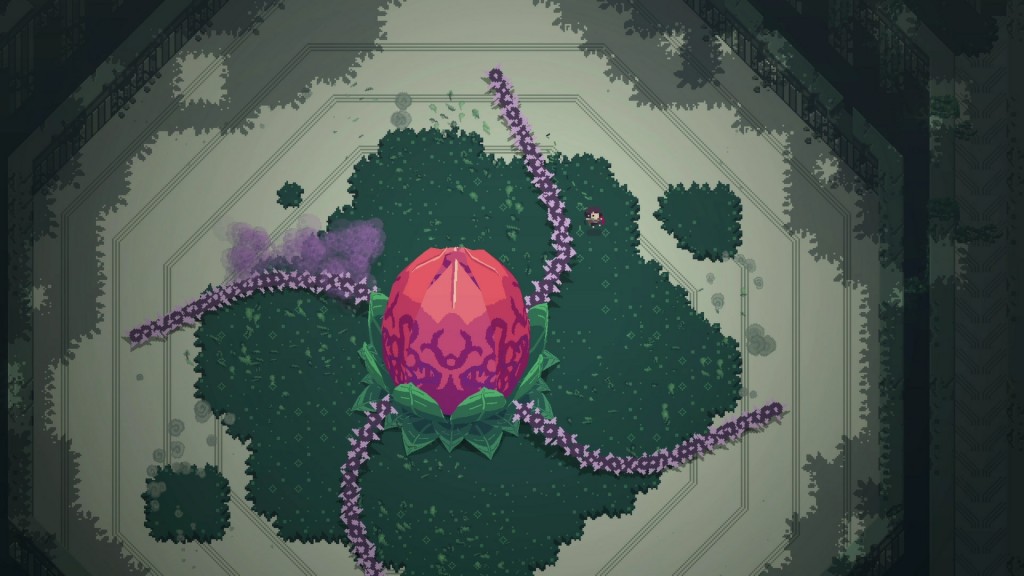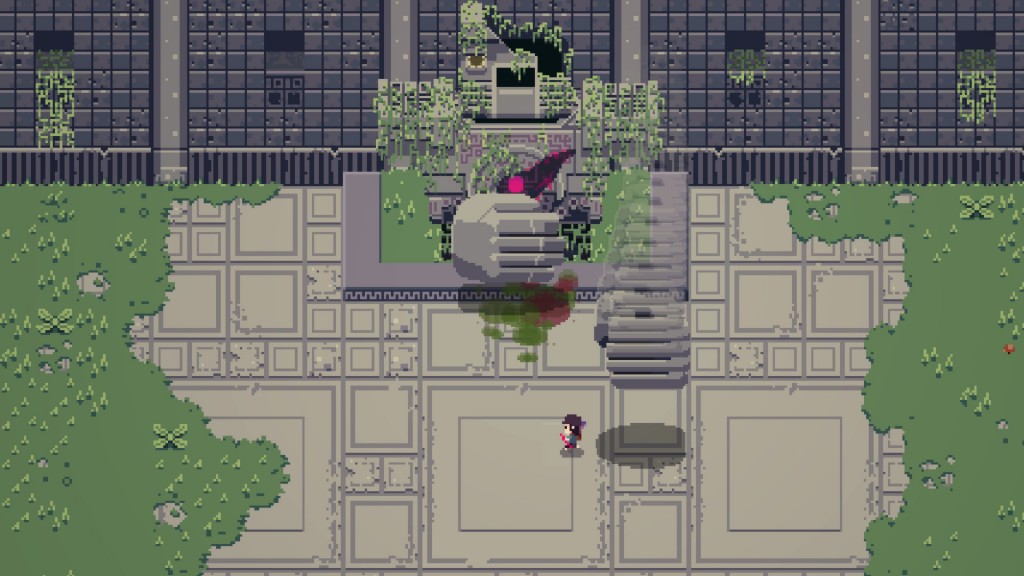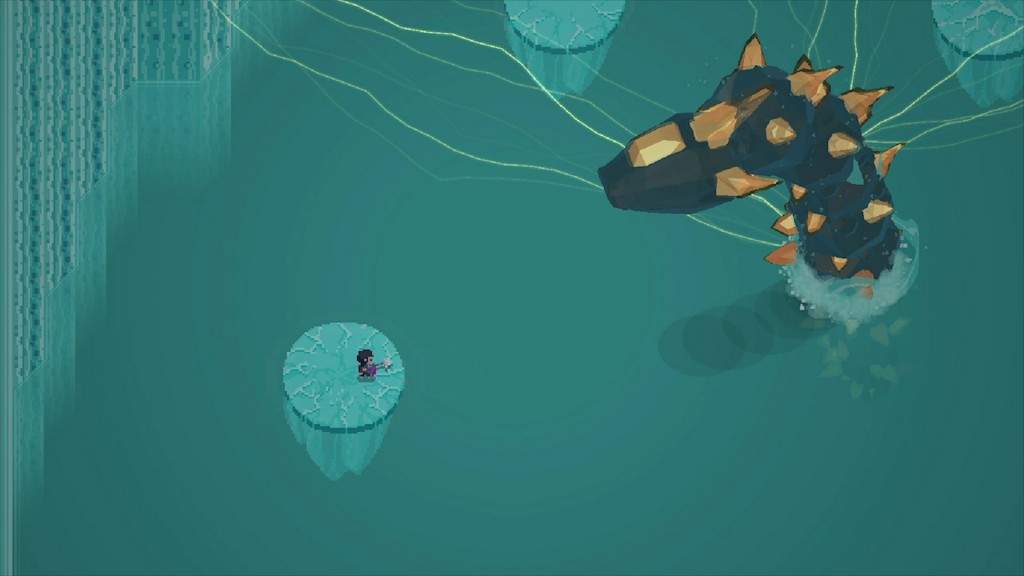
Titan Souls began its life as a game created for a game jam, “Ludum Dare 28: You Only Get One.” These competitions challenge designers to build a game from start to finish centered around a given concept in only a single weekend. In many ways, “you only get one” is the ideal motto for Titan Souls, as you only get one hit before death, you only get one arrow with which to kill the many bosses and you only need one hit on each boss to kill it. Getting this one hit in on each of the many varied bosses of Titan Souls proves to be an intense, but also extremely gratifying, experience. After each narrow victory, I automatically found myself gritting my teeth, breathing heavily and pumping my fist in the air, and I wanted nothing more than to do it again.
It only takes a few seconds to understand the mechanics behind Titan Souls. Your basic attack is to fire an arrow, which flies a distance dictated by how long you hold the fire button before releasing. After firing, you must retrieve your arrow before attacking again, and this can be done by running to it or by holding the fire button down and having the arrow be drawn back to you. You are immobile while charging an attack, so balancing the strength of the shot against the need to move away from the enemy becomes a major element of many battles.
To aid you in your defenses, you also have a dive roll, which basically moves you quickly in the direction of motion and also gives you a brief moment of invulnerability. The catch with this, however, is that there is a very slight window after rolling before you can roll again (no matter how much you mash the button), so you can’t just spam the dodge whenever you want. You have to time your dodges correctly to avoid damage and set up the one available opportunity to get in the single hit needed to defeat a given boss.

The entire concept of Titan Souls beyond this very basic control scheme is just a gauntlet of boss battles, each one varied in mechanic and style. A typical cycle of attempts for a given boss is something along the lines of “die immediately,” “die more slowly while learning to dodge,” “die even more slowly while discovering the boss’s weak point,” “die quickly when first attempting to hit the weak point”and “make the miracle shot that wins the battle and sit in stunned silence for a moment.” This cycle is then repeated over and over, and I was amazed at the number of different ways Titan Souls managed to vary the feel of this core gameplay loop while not changing its basic premise.
With such a simple formula, the success of Titan Souls lies squarely with the variety and challenge of its boss designs. Luckily, this is one area that developer Acid Nerve absolutely nails it. No two bosses are identical, and a lot of the fun of fighting them comes from the struggle to stay alive just long enough to determine what it is you’ll need to do to actually win.
The bosses all have a visual cue to show where and how to hit them, so looking for this while experiencing all the various ways the boss can kill you becomes the main focus the first few encounters you have. There were a large number of times when I had a dawning moment, a split-second when I did something by accident and saw a glimpse of victory. I loved the feeling of discovery I got from each encounter, and this was likely the largest driving force in drawing me further and further into the game.

You die a lot in Titan Souls, and Acid Nerve smartly realized this and put checkpoints near each boss room to make replaying multiple attempts of each boss a breeze. The load times are very minimal, so rather than become a source of frustration, death just became a part of the gameplay. If anything, the fact that it was so easy to just run a screen or two over and fight the boss again motivated me to keep trying rather than skip out and take a break when losing multiple times in a row. I would be at just about the point when I needed to quit, and then I’d see the boss room and have the overwhelming urge for just one more try.
If there is anything to knock about Titan Souls, it may be that it just doesn’t last long enough or have anything to draw you back after completing it. I finished the game in under four hours, and this included taking down most of the bosses. You aren’t required to defeat every boss to see the credits, just enough to unlock each of the various gates in your path. After beating the game, you unlock modifiers that you can try, like hard mode, one-death mode and no-dodge-rolls mode. If you’re a complete madman, you can toggle them all on together. I thought that the difficulty of the game was ideal already, though, and the incentive of just playing it again with faster bosses wasn’t particularly appealing.
The one place that the game probably will live on, though, is in the speedrunning community. Titan Souls feels like it was built for speed runs, as once you learn how to beat a boss, you can theoretically do it very quickly. I am excited to watch people much more skilled than me tear through this game with mind-blowing tactics that I can’t even imagine, and I’m grateful that the game has enough depth to support that.

The cute pixelated aesthetic of Titan Souls pairs well with its demanding gameplay. The controls feel tight, the challenge feels finely tuned and the entire game oozes a high level of polish. It should have a fairly wide appeal, as it manages to be approachable despite being difficult, and it provides a satisfying ego boost every time you manage to make it past another boss. Uncompromising in difficulty and forgiving of failure, Titan Souls is the hard game for people that don’t really enjoy hard games.
Pros: Well-balanced gameplay, boss variety, visual style
Cons: Low replayability if not looking for an extreme challenge



















